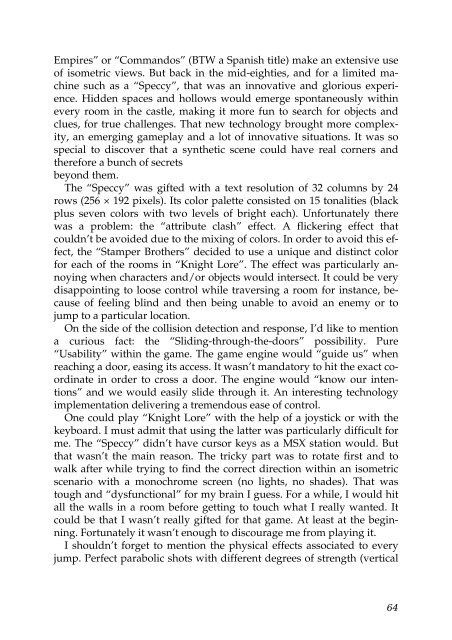Well Played 2.0: Video Games, Value and Meaning - OpenLibra
Well Played 2.0: Video Games, Value and Meaning - OpenLibra
Well Played 2.0: Video Games, Value and Meaning - OpenLibra
Create successful ePaper yourself
Turn your PDF publications into a flip-book with our unique Google optimized e-Paper software.
Empires” or “Comm<strong>and</strong>os” (BTW a Spanish title) make an extensive use<br />
of isometric views. But back in the mid-eighties, <strong>and</strong> for a limited machine<br />
such as a “Speccy”, that was an innovative <strong>and</strong> glorious experience.<br />
Hidden spaces <strong>and</strong> hollows would emerge spontaneously within<br />
every room in the castle, making it more fun to search for objects <strong>and</strong><br />
clues, for true challenges. That new technology brought more complexity,<br />
an emerging gameplay <strong>and</strong> a lot of innovative situations. It was so<br />
special to discover that a synthetic scene could have real corners <strong>and</strong><br />
therefore a bunch of secrets<br />
beyond them.<br />
The “Speccy” was gifted with a text resolution of 32 columns by 24<br />
rows (256 × 192 pixels). Its color palette consisted on 15 tonalities (black<br />
plus seven colors with two levels of bright each). Unfortunately there<br />
was a problem: the “attribute clash” effect. A flickering effect that<br />
couldn’t be avoided due to the mixing of colors. In order to avoid this effect,<br />
the “Stamper Brothers” decided to use a unique <strong>and</strong> distinct color<br />
for each of the rooms in “Knight Lore”. The effect was particularly annoying<br />
when characters <strong>and</strong>/or objects would intersect. It could be very<br />
disappointing to loose control while traversing a room for instance, because<br />
of feeling blind <strong>and</strong> then being unable to avoid an enemy or to<br />
jump to a particular location.<br />
On the side of the collision detection <strong>and</strong> response, I’d like to mention<br />
a curious fact: the “Sliding-through-the-doors” possibility. Pure<br />
“Usability” within the game. The game engine would “guide us” when<br />
reaching a door, easing its access. It wasn’t m<strong>and</strong>atory to hit the exact coordinate<br />
in order to cross a door. The engine would “know our intentions”<br />
<strong>and</strong> we would easily slide through it. An interesting technology<br />
implementation delivering a tremendous ease of control.<br />
One could play “Knight Lore” with the help of a joystick or with the<br />
keyboard. I must admit that using the latter was particularly difficult for<br />
me. The “Speccy” didn’t have cursor keys as a MSX station would. But<br />
that wasn’t the main reason. The tricky part was to rotate first <strong>and</strong> to<br />
walk after while trying to find the correct direction within an isometric<br />
scenario with a monochrome screen (no lights, no shades). That was<br />
tough <strong>and</strong> “dysfunctional” for my brain I guess. For a while, I would hit<br />
all the walls in a room before getting to touch what I really wanted. It<br />
could be that I wasn’t really gifted for that game. At least at the beginning.<br />
Fortunately it wasn’t enough to discourage me from playing it.<br />
I shouldn’t forget to mention the physical effects associated to every<br />
jump. Perfect parabolic shots with different degrees of strength (vertical<br />
64

















